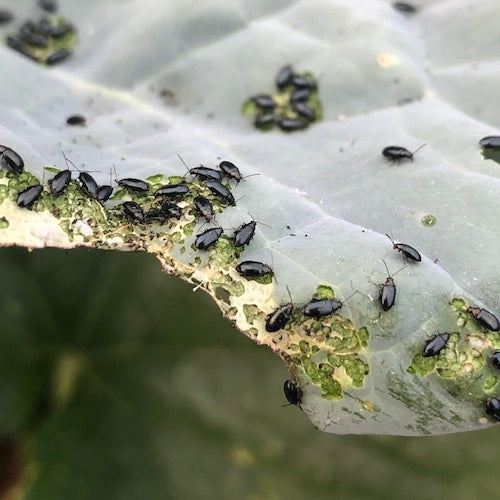In spite of the drought and very hot weather, veggie gardens around town have been looking lush and productive, the trial garden at Sage included. So it has been a bit of a blow to see the rampant return of flea beetles, fresh off nearby canola fields. From first beetle sighting to the mass decimation of broccoli, nasturtiums, horseradish and kale seems to take only a day or two, which leaves a lot of gardeners asking, "is there anything I can do?"

First, the good news. Yes, there are a few things we can do to reduce the carnage and fortunately flea beetles are very specific about which crops they chew up. Tomatoes, peppers, melons, squash, carrots, beans... all safe! The bad news is that the flea beetles showing up now are arriving en mass from farmer's fields, so there is no effective way to halt their arrival - and there are billions of them.
If you are lucky and flea beetles have yet to appear in your garden, you still have time for the ultimate defence: cover your susceptible crops. You will want to use fine insect mesh or crop cover; both options allow adequate light through but effectively keep adult flea beetles out. Some gardeners simply drape the cloth over plants and then secure on the ground with rocks; others create simple hoops with irrigation pipe and secure the cloth over the structure. In all cases, the cloth has to be completely secured so there are no small openings the beetles can get through. Keep it simple, but be sure you can still access your plants to water and harvest.

Insect screen needs to be fine enough to keep the relatively small flea beetles out
Once flea beetles are present it is difficult to use cover, since the beetles may then simply be stuck under the cloth and enjoy free reign of your plants. At this point, you may consider getting your shop vacuum out and suck up as many of the small beetles as you can... for real! Although more of the pests are gong to arrive, you may be able to control the damage they do by regularly reducing the number of adults present on your plants each day (just be careful not to suck up nice leaves while you are at it).
Although insecticides such a Safer's Soap and End-All are not effective against flea beetles, diatomaceous earth can be. This non-toxic insecticide is made of pulverized fossils, and works by scuffing the joints of many beetles and similar pests (so there is no chemical toxicity involved). To be effective, diatomaceous earth needs to be sprinkled where the flea beetles are active, so sprinkle liberally onto affected crops. Once again, bear in mind that even as today's flea beetles are controlled many more could arrive tomorrow - so intervention needs to be ongoing.
A final strategy is to use flea beetle's strong preference for certain plants as a lure; for example, you could allow them to feast on your tough-as-nails horseradish plants while you use the earlier outlined strategies on annual brassicas that you have worked hard at raising this season. Horseradish can be completely eaten down and will grow back just fine while the opportunity to get broccoli heads only comes around once per year. Similarly, some gardeners plant fast growing annuals like nasturtiums or regular radishes specifically to bait flea beetles (it is not too late late to plant radishes for this purpose, although the current wave of flea beetles will likely only last a few weeks).
One last thought is to consider the pay-it-forward benefits of preventing large numbers of flea beetles from staying too cozy in your August garden. At the moment, the pests showing up are coming from agricultural land seeking out your plants; but these flea beetles are the ones overwintering in your garden and laying eggs for next spring. Spring beetles can be effectively controlled with beneficial nematodes, but the less eggs that are laid the less of a challenge they are in spring.







